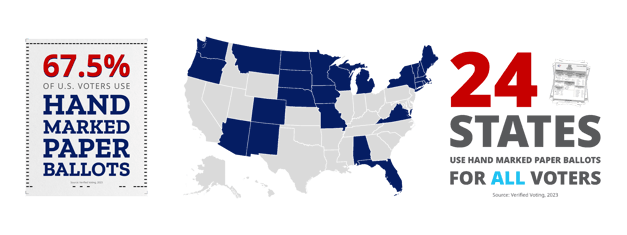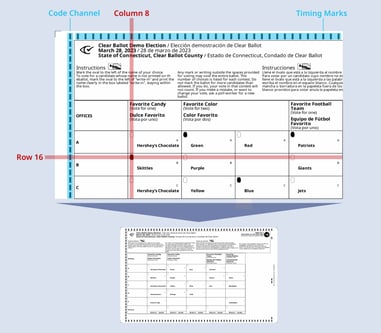It’s a refrain that election officials and the public have been hearing for more than three years now: voter confidence in election results is at a dangerously low level. While some recent surveys show that voter confidence in the elections since 2020 has begun to increase, there are still significant variations in voter confidence depending on an individual’s party affiliation and location.1 Misinformation and distrust also continue to be among the top concerns for election officials as they reflect on their job and responsibilities over the last year.2
However, there is a surprisingly simple and time-tested solution that can increase voter confidence and transparency in American elections – using voter verifiable paper ballots for everyone. These ballots would be truly verifiable to the human eye, with accommodations for voters with disabilities to be able to verify their ballots, and completely auditable. The good news is that these ballots are already in use in jurisdictions across the country.
Defining a Voter Verifiable Ballot
In the technology sector, most definitions of verifiability revolve around proving that someone is a real human, and not a computer, but in the elections world, it is important to define what voter verifiable means in a practical sense. For a ballot to be fully voter verifiable, it should be able to be visually inspected by a sighted voter who can confirm, without the use of scanning or other computer technology, that the markings on the ballot match their intended selections in each contest before it is tabulated. The gold standard then of a voter verifiable ballot would be a hand or machine marked full-faced paper ballot that displays each contest and candidate with clearly marked voter selections.
Prevalence of Voter Verifiable Ballots in the United States
According to the most recent data, 67.5% of US voters will vote using hand marked paper ballots (with Ballot Marking Devices (BMDs) or Direct Recording Electronic (DRE) devices with Voter Verifiable Paper Audit Trail (VVPAT) printers available for voters with disabilities) in the 2024 elections.3
That includes 24 states in which all voters will use hand marked paper ballots and hundreds of other counties who have chosen that option across the country.3

The number of jurisdictions using voter verifiable paper ballots has grown exponentially in recent years, up from 31.5% in 2008 and 47.9% in 2016.3 That number is expected to continue climbing as states and jurisdictions using older model DREs replace their aging equipment with new systems that provide a paper trail for voters.
Transparency in Tabulation
Hand marked, full-faced paper ballots are the gold standard for voter verifiability because they offer sighted voters the ability to visually verify that their ballot reflects their intended selections before tabulation. The most prevalent full-faced paper ballot systems use optical scan technology to read voters’ selections (usually in the form of a filled in oval) and tally votes. These systems use a unique identifier in the form of a barcode, QR code, or set of timing marks (known as a code channel) to tell the tabulating device what style of ballot it is reading. This is important because unique ballot styles will have different contests and candidates with corresponding contest zones. However, unlike summary ballots, full-faced paper ballots do not tabulate off these barcodes or QR codes and instead simply use them as a map to identify contest zones and scan for voter selections.
The graphic below illustrates an example of a voter-verifiable paper ballot that uses timing marks to identify oval positions.

The tabulation system uses this map to determine where votes should be – the individual ovals on the ballot– and scans these zones for voter markings. If a voter has filled in the oval associated with a contest, the tabulator then knows to count that as a vote and assigns it to the corresponding candidate. With a full-faced ballot, sighted voters can verify their selections easily by checking their ballot and ensuring that the ovals they have filled in correctly match the choices that they were intending to make before casting their ballot. For voters who are blind or need accommodations for visual impairments, ballot marking devices offer voters the opportunity to review their selections by audibly reading the selections chosen for each contest before the ballot is printed and then cast. Several accessible solutions currently in use by jurisdictions create full-faced paper ballots for voters who use ballot marking devices as well, so that those ballots are indistinguishable from those marked by hand.
While ballots that tabulate off QR codes or barcodes can be verifiable using technology, they are not inherently voter verifiable because a voter cannot verify their selections independent of the system or without the use of a separate piece of technology. Voters can attempt to verify their selections have been recorded accurately by reading the text summary on the ballot, but they do not have a way of confirming that the text summary matches the encoded selections without using a barcode or QR code reader. This presents a significant barrier to true voter verifiability.
Auditability
One of the greatest benefits of a full-faced paper ballot beyond immediate voter verifiability is that they are also the most auditable form of ballot, compatible with all modern auditing methods. Because these ballots are able to be verified without the assistance of additional technology, they can be used in manual audits as well as in the case of a risk-limiting audit. If there were ever a mandated recount or manual inspection of the ballots, voter selections are clearly identified and can be counted as the official record of the election. With ballots that utilize barcodes or QR codes, the summary text can be audited but to fully verify the accuracy of results, another technology such as a barcode reader or a software that is capable of reading those ballots and doing a secondary verification would need to be employed.
Restoring Trust
As our nation prepares for the 2024 elections and the potential for significant scrutiny that our institutions and elections officials will unfairly face, it is imperative that stakeholders in the elections process work to increase voter confidence and combat distrust whenever possible. This is an effort that should fall not just on jurisdictions, but also their vendors and partners throughout the elections industry.
Providing clear, easy-to-understand information about the elections process and how votes are cast and counted can help voters feel more comfortable in casting their ballot and engaging with the democratic process. The growth of hand-marked, voter verifiable paper ballots in recent years is a positive step toward increasing transparency in the tabulation process. Voter verifiable paper ballots represent the gold standard of simplicity and auditability in elections and their longevity in our elections process is a testament to their value. By empowering voters to easily verify their choices before their ballots are cast, full-faced paper ballots offer a time-tested solution to the modern question of how to restore voter confidence.
1 The Center for Election Innovation & Research, 2022.
2 Reed College Elections & Voting Information Center, 2023.
ABOUT CLEAR BALLOT
As the leader in election innovation, Clear Ballot has introduced a new class of tools and a modern approach to voting, enabling unprecedented speed, accuracy, and transparency that officials and the voting public have sought for decades. Clear Ballot entered the election industry with its first product in 2012, disrupting the industry with the nation’s first independent, automated audit, and four years later developed a complete voting system which is now the fastest growing voting system in the industry. Clear Ballot’s election technology is currently used in thirteen states, serving more than 40 million registered voters.

